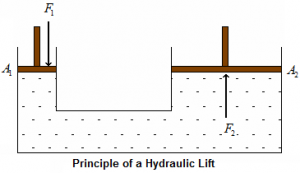Pascal’s Law
According to this principle, the external static pressure applied on a confine liquid is distributed or transmitted evenly throughout the liquid in all directions. The static pressure acts at right angles to any surface in contact with the fluid. Pascal also found that the pressure at a point for a static fluid would be same across all planes passing through that point in that fluid.
What is Pascal’s Law?
Pascal’s Law states that when there is an increase in pressure at any point in a confined fluid, there is an equal increase at every other point in the container. Pascal’s law is also given as, if the effect of gravitation is neglected, the pressure at every point in an incompressible liquid, in equilibrium is the same.

The figure above shows the principle of a hydraulic lift used to raise heavy loads. This device has two vertical cylinders of different diameters connected by a horizontal tube. A liquid is filled in this vessel. Airtight pistons having cross – sectional areas A₁ and A₂ (A₁ < A₂) are fitted touching the liquid surface on both the cylinders. According to Pascal’s Law, in equilibrium the pressure on liquid in both the arms is the same.
Hence,
P₁ = P₂
\(\frac{{{F}_{1}}}{{{A}_{1}}}\,\,=\,\,\frac{{{F}_{2}}}{{{A}_{2}}}\),
\({{F}_{2}}\,\,=\,\,\frac{{{F}_{1}}{{A}_{2}}}{{{A}_{1}}}\),
Thus, the large force (F₂) is generated using a small force (F₁), as the magnitude of F₂ is \(\left[ \frac{{{A}_{2}}}{{{A}_{1}}} \right]\) times the magnitude of F₁. By using Pascal’s Law, devices like hydraulic lift, hydraulic jack, and hydraulic press are developed.
